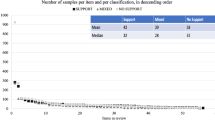Abstract
An analysis of the Afro-Asiatic prefixal conjugation is presented, arguing that the prefixal t of second and some third persons comprises two distinct morphemes. The claim is supported by intralinguistic evidence, from other verbal and non-verbal forms, and historical/comparative evidence, that has not generally been considered in this context before. The results highlight several methodological and conceptual issues in morphological theory, including the status of homophones, paradigms, and diachronic development.
Similar content being viewed by others
References
Anderson S. (1992) A-morphous morphology. Cambridge University Press, Cambridge
Arad M. (2005) Roots and patterns: Hebrew morpho-syntax. Springer, Dordrecht
Bachrach, A., Nelvins, A. (eds) (2008) Inflectional identity. Oxford University Press, Oxford
Benmamoun E. (2000) The feature structure of functional categories: A comparative study of Arabic dialects. Oxford University Press, Oxford
Bobaljik J. (2001) Syncretism without paradigms: Remarks on Williams 1981, 1984. In: Booij G., van Marle J. (eds) Yearbook of morphology 2001. Kluwer, Dordrecht, pp 53–86
Borer H. (1983) Parametric syntax. Case studies in Semitic and Romance languages. Studies in Generative Grammar 13. Dordrecht, Foris
Buccellati G. (1997) Akkadian. In: Hetzron R. (eds) The Semitic languages. Routledge, New York, NY, pp 69–99
Fischer W. (1997) Classical Arabic. In: Hetzron R. (eds) The Semitic languages. Routledge, New York, NY, pp 187–219
Frampton J. (2002) Syncretism, impoverishment, and the structure of person features. In: Andronis M., Debenport E., Pycha A., Yoshimori K. (eds) Papers from the Chicago Linguistics Society 38. Chicago Univerity Press, Chicago, pp 207–222
Gragg G. (1997) Ge‘ez (Ethiopic). In: Hetzron R. (eds) The Semitic languages. Routledge, New York, NY, pp 242–260
Gutt E.-A. (1997) The Silte group (East Gurage). In: Hetzron R. (eds) The Semitic languages. Routledge, New York, NY, pp 509–534
Halle, M. (1997). Distributed Morphology: Impoverishment and Fission. In B. Bruening, Y. Kang, & M. McGinnis (Eds.), MIT working papers in linguistics 30: PF: Papers at the interface (425–449). MIT. (Reprinted in Research in Afroasiatic Grammar: Papers from the Third Conference on Afroasiatic Languages, Sophia Antipolis, France 1996, pp. 125–150, by Jacqueline Lecarme and Jean Lowenstamm & Ur Shlonsky, (Eds.), 2003, Amsterdam: Benjamins.).
Halle M., Marantz A. (1993) Distributed Morphology and the pieces of inflection. In: Hale K., Keyser S.J. (eds) The view from Building 20. MIT Press, Cambridge, pp 111–176
Harbour D. (2007) Against PersonP. Syntax 10: 223–243
Harbour D. (2008) Discontinuous agreement and the Syntax–Morphology interface. In: Harbour D., Adger D., Béjar S. (eds) Phi theory: Phi-features across modules and interfaces. Oxford University Press, Oxford, pp 185–220
Harley H. (2008) When is a syncretism more than a syncretism? Impoverishment, metasyncretism, and underspecification. In: Harbour D., Adger D., Béjar S. (eds) Phi theory: Phi-features across modules and interfaces. Oxford University Press, Oxford, pp 251–294
Hetzron R. (1997) Outer South Ethiopic. In: Hetzron Robert (eds) The Semitic languages. Routledge, New York, NY, pp 535–549
Hudson G. (1997) Amharic and Argobba. In: Hetzron R. (eds) The Semitic languages. Routledge, New York, NY, pp 457–485
Huehnergard, J. (2002). Comparative Semitic linguistics. Israel Oriental Studies, 20, 119–150. [Special issue, Shlomo Izre’el, ed., Semitic Linguistics: The State of the Art at the Turn of the Twenty-First Century].
Jastrow O. (1997) The neo-Aramaic languages. In: Hetzron R. (eds) The Semitic languages. Routledge, New York, NY, pp 334–377
Johnstone T.M. (1977) Ḥarsūsi Lexicon and English–Ḥarsūsi Word-List. Oxford University Press, London
Kautzsch, E. (1910). Genesius’ Hebrew grammar (2nd ed.). (A. E. Cowley, Trans./Ed.). Oxford: Clarendon Press.
Kaye A., Rosenhouse J. (1997) Arabic dialects and Maltese. In: Hetzron R. (eds) The Semitic languages. Routledge, New York, NY, pp 263–311
Kogan L. (1997) Tigrinya. In: Hetzron R. (eds) The Semitic languages. Routledge, New York, NY, pp 424–445
Lieber R. (1992) Deconstructing morphology. Chicago University Press, Chicago
Noyer R. (1992) Features, positions and affixes in autonomous morphological structure. MITWPL, Cambridge, MA
Raz S. (1997) Tigré. In: Robert Hetzron (eds) The Semitic languages. Routledge, New York, NY, pp 446–456
Rosenthal F. (1961) A grammar of Biblical Aramaic 5th ed., 1983). Otto Harrassowitz, Wiesbaden
Segert S. (1997) Phoenician and the eastern Canaanite languages. In: Hetzron R. (eds) The Semitic languages. Routledge, New York, NY, pp 174–186
Simeone-Senelle M.-C. (1997) The modern South Arabian languages. In: Hetzron R. (eds) The Semitic languages. Routledge, New York, NY, pp 378–423
Sivan R., Levenston E. (1975) The new Bantam-Megiddo Hebrew and English dictionary. Bantam Books, New York, NY
Wagner E. (1997) Harari. In: Hetzron R. (eds) The Semitic languages. Routledge, New York, NY, pp 486–508
Author information
Authors and Affiliations
Corresponding author
Rights and permissions
About this article
Cite this article
Harbour, D. On homophony and methodology in morphology. Morphology 18, 75–92 (2008). https://doi.org/10.1007/s11525-009-9123-z
Received:
Accepted:
Published:
Issue Date:
DOI: https://doi.org/10.1007/s11525-009-9123-z



